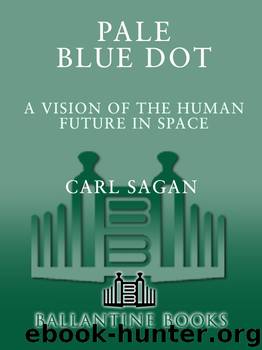Pale Blue Dot: A Vision of the Human Future in Space by Carl Sagan & Ann Druyan

Author:Carl Sagan & Ann Druyan [Sagan, Carl]
Language: eng
Format: azw3
ISBN: 9780307801012
Publisher: Random House Publishing Group
Published: 2011-07-06T04:00:00+00:00
When President Kennedy formulated the Apollo program, the Defense Department had a slew of space projects under development—ways of carrying military personnel up into space, means of conveying them around the Earth, robot weapons on orbiting platforms intended to shoot down satellites and ballistic missiles of other nations. Apollo supplanted these programs. They never reached operational status. A case can be made then that Apollo served another purpose—to move the U.S.-Soviet space competition from a military to a civilian arena. There are some who believe that Kennedy intended Apollo as a substitute for an arms race in space. Maybe.
For me, the most ironic token of that moment in history is the plaque signed by President Richard M. Nixon that Apollo 11 took to the Moon. It reads: “We came in peace for all mankind.” As the United States was dropping 7½ megatons of conventional explosives on small nations in Southeast Asia, we congratulated ourselves on our humanity: We would harm no one on a lifeless rock. That plaque is there still, attached to the base of the Apollo 11 Lunar Module, on the airless desolation of the Sea of Tranquility. If no one disturbs it, it will still be readable a million years from now.
Six more missions followed Apollo 11, all but one of which successfully landed on the lunar surface. Apollo 17 was the first to carry a scientist. As soon as he got there, the program was canceled. The first scientist and the last human to land on the Moon were the same person. The program had already served its purpose that July night in 1969. The half-dozen subsequent missions were just momentum.
Apollo was not mainly about science. It was not even mainly about space. Apollo was about ideological confrontation and nuclear war—often described by such euphemisms as world “leadership” and national “prestige.” Nevertheless, good space science was done. We now know much more about the composition, age, and history of the Moon and the origin of the lunar landforms. We have made progress in understanding where the Moon came from. Some of us have used lunar cratering statistics to better understand the Earth at the time of the origin of life. But more important than any of this, Apollo provided an aegis, an umbrella under which brilliantly engineered robot spacecraft were dispatched throughout the Solar System, making that preliminary reconnaissance of dozens of worlds. The offspring of Apollo have now reached the planetary frontiers.
If not for Apollo—and, therefore, if not for the political purpose it served—I doubt whether the historic American expeditions of exploration and discovery throughout the Solar System would have occurred. The Mariners, Vikings, Pioneers, Voyagers, and Galileo are among the gifts of Apollo. Magellan and Cassini are more distant descendants. Something similar is true for the pioneering Soviet efforts in Solar System exploration, including the first soft landings of robot spacecraft—Luna 9, Mars 3, Venera 8—on other worlds.
Apollo conveyed a confidence, energy, and breadth of vision that did capture the imagination of the world. That too was part of its purpose.
Download
This site does not store any files on its server. We only index and link to content provided by other sites. Please contact the content providers to delete copyright contents if any and email us, we'll remove relevant links or contents immediately.
Tools of Titans by Timothy Ferriss(8211)
Turbulence by E. J. Noyes(7933)
Secrets of Antigravity Propulsion: Tesla, UFOs, and Classified Aerospace Technology by Ph.D. Paul A. Laviolette(5309)
Astrophysics for People in a Hurry by Neil DeGrasse Tyson(5129)
Room 212 by Kate Stewart(5034)
Design of Trajectory Optimization Approach for Space Maneuver Vehicle Skip Entry Problems by Runqi Chai & Al Savvaris & Antonios Tsourdos & Senchun Chai(5011)
Pale Blue Dot by Carl Sagan(4903)
The David Icke Guide to the Global Conspiracy (and how to end it) by David Icke(4624)
A Journey Through Divination and Astronomy by Publishing Pottermore(4339)
Goodbye Paradise(3724)
Apollo 8 by Jeffrey Kluger(3634)
COSMOS by Carl Sagan(3552)
Losing the Nobel Prize by Brian Keating(3497)
The Five People You Meet in Heaven by Mitch Albom(3473)
How to Read Water: Clues and Patterns from Puddles to the Sea (Natural Navigation) by Tristan Gooley(3406)
Brief Answers to the Big Questions by Stephen Hawking(3368)
How to Read Nature by Tristan Gooley(3246)
The Order of Time by Carlo Rovelli(3144)
A Brief History of Time by Stephen Hawking(2958)
